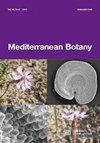地中海型生态系统中的植物保护
IF 0.7
4区 生物学
Q3 PLANT SCIENCES
引用次数: 11
摘要
本文综述了地中海型生态系统(MTEs)植物保护的最新进展,重点介绍了目前的研究和被忽视的问题。本文回顾了有关植物保护生物学的相关文献,并对研究结果进行了总体分析。主要议题包括:1)生殖生物学和遗传保护;2)全球变化的威胁因素和影响;3)保护状况评估和保护区选择。这项研究表明,地中海盆地北部国家发表的关于南部和东部国家的文件数量与其他mte相比存在差异。它还强调了公共组织作为资助实体的首要重要性。此外,它指出与植物保护相关的传统学科类别减少,多学科保护研究和新方法(如系统基因组学,SDM)增加。为了克服不同MTE区域之间存在的偏见,有必要在跨国一级采取综合行动,并制定标准的保护政策和战略。此外,研究应得到私人实体更重要的参与和资助,并明确侧重于具体的保护建议。相比之下,发现了某些弱点,其中一些与有关受威胁植物物种的现有资料有限以及管理计划中很少使用遗传保护研究的现有数据有关。因此,作者认为,未来的保护工作应致力于提高对受威胁的mte植物区系的认识,并实施良好做法手册,从而利用现有的研究信息提出更直接的管理和保护建议。本文章由计算机程序翻译,如有差异,请以英文原文为准。
Plant conservation in Mediterranean-type ecosystems
The present paper is an overview of state of the art in plant conservation in Mediterranean-type Ecosystems (MTEs), highlighting current studies and neglected topics. A review of the literature dealing with this issue and a general analysis of the results was performed, delving into relevant plant conservation biology topics. The main topics considered were: 1) reproductive biology and genetic conservation, 2) threat factors and effects of global change, and 3) evaluation of conservation status and protected areas selection. This study illustrates differences in the number of documents published in northern countries of the Mediterranean Basin concerning southern and eastern countries and compared with other MTEs. It also highlights the paramount importance of public organizations as funding entities.
Additionally, it points to a decrease in traditional subject categories related to plant conservation and increased multidisciplinary conservation research and novel methodologies (e.g., phylogenomics, SDM). To overcome existing biases among the different MTE regions, integrating actions at a transnational level would be necessary, with standard conservation policies and strategies. Moreover, research should be supported with more important participation and funding from private entities, with a clear focus on specific conservation proposals. In contrast, certain weaknesses were detected, some related to the limited information available about threatened plant species and the scarce use of the available data from genetic conservation research in management plans. Consequently, the authors consider that future conservation efforts should be addressed to improve the knowledge of threatened MTEs’ flora and implement a manual of good practices, which would make use of the available research information to put forward more direct proposals for management and conservation.
求助全文
通过发布文献求助,成功后即可免费获取论文全文。
去求助
来源期刊

Mediterranean Botany
Agricultural and Biological Sciences-Plant Science
CiteScore
2.40
自引率
10.00%
发文量
30
审稿时长
12 weeks
期刊介绍:
Mediterranean Botany (ISSNe 2603-9109), formerly Lazaroa, is a biannual journal that publishes original research studies in the field of Botany including plant systematics, vegetation ecology, biogeography, evolutionary biology, ecophysiology, community ecology, ethnobotany and conservation biology on Mediterranean biomes but also in interacting areas.
Mediterranean Botany is an OPEN ACCESS Journal, free of charges for any published article.
 求助内容:
求助内容: 应助结果提醒方式:
应助结果提醒方式:


